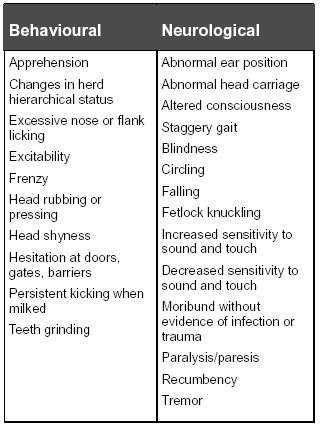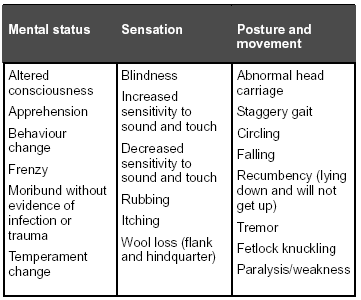



TSE Surveillance
Sally Spence, Technical Specialist, Field Veterinary services and Product Integrity and Sarah Aitken, Veterinary Intern, at the New South Wales Department of Primary Industries looks at the Australian surveillance system for transmissible spongiform encephalopathies, including BSE.What are TSEs?
TSEs (transmissible spongiform encephalopathies) or prion diseases are a group of rare brain diseases caused by infectious protein-like particles known as prions that lead to the formation of tiny holes in the brain that can be seen under a microscope. These diseases are progressive and lead to neurological signs and death.
Prion diseases have been described in humans, cattle, sheep, goats, deer and other mammals and there is no vaccination or treatment for them.
Why we need surveillance in Australia
Australia is currently free from TSEs, including BSE in cattle (Bovine spongiform encephalopathy or ‘Mad cow disease’) and scrapie in sheep and goats. The presence of these diseases overseas, particularly in the United Kingdom, has led to extensive damage to their domestic and export markets and slaughtering of affected animals. Similar losses would be expected to occur in Australia if TSEs were to infect our sheep and cattle. The existence of BSE also has major public health risks as the infectious agent responsible for the disease in cattle is implicated as the cause of a human TSE known as new variant Creutzfeldt-Jakob disease (nvCJD). New variant Creutzfeldt-Jakob disease is a rapidly progressive TSE that is thought to occur in people after they consume products from BSE infected cattle.
Appropriate surveillance measures for TSEs in Australia allow us to demonstrate to export markets that our animals and animal products are free from TSEs. This increases the number of export markets available to Australia and therefore benefits producers and the economy. Adequate surveillance and the economy. Adequate surveillance is also important for early detection and intervention should a TSE be found in Australia.
The important public health issues surrounding BSE are another reason why surveillance for TSEs is vital in Australia.
National TSE Freedom Assurance Program (NTSEFAP)
The NTSEFAP has been developed with the following aims:
- prevent TSE entrance into Australia;
- increase our levels of surveillance for TSEs;
- reduce/eliminate the risk of spread among animals, and between animals and people, should a TSE occur in Australia;
- increase public awareness and understanding of TSEs and the importance of surveillance measures.
The preventative and surveillance strategies included in the NTSEFAP help to prove that Australia is TSE free and as a result boost our export opportunities
National TSE Surveillance Program (NTSESP)
Australia has operated surveillance programs for BSE and scrapie for many years. More passive methods of surveillance include on-farm inspections of animals by private and government vets, examination of animals before and after death at slaughter, and inspection of animals destined for live export.
The NTSESP is an active surveillance program managed by Animal Health Australia and was developed to demonstrate Australia’s ongoing freedom from BSE and scrapie. The NTSESP also serves as a means for early detection of BSE and scrapie should these diseases occur in Australia. The program involves field investigations by government and private veterinarians of animals wherever there is suspicion of TSE based on the clinical signs.
BSE in cattle
The main clinical signs associated with BSE in cattle are:
- increased nervousness;
- staggery gait;
- increased sensitivity to touch and sound;
- muscle tremors.
Cattle can be infected with BSE long before displaying clinical signs; signs usually appear when animals are older than 2 years of age.
Although the above signs are the main clinical features associated with BSE, TSE testing can be carried out on any cattle that fit the following criteria:
- 30 months of age or more and less than 9 years of age;
- refractory to treatment; and
- display one or more of the following clinical signs.

Scrapie in sheep
The main clinical signs associated with scrapie in sheep are:
- persistent itching;
- staggery gait
- wasting.
There is usually a gradual onset of clinical signs in sheep between 2 and 5 years of age. Just like cattle with BSE, sheep can be infected with scrapie long before clinical signs appear.
Sheep that fit the following criteria are eligible for TSE testing:
- 18 months of age or more; and
- display one or more of the following clinical signs.

The role of veterinarians
The Australian NTSESP currently requires a total of 400 brains from eligible cattle and 450 brains from eligible sheep to be submitted for TSE testing to assure the international community that Australia is TSE-free.
Government and private veterinarians are required to submit the brains and a section of spinal cord from animals that fit the above criteria. In New South Wales the appropriate samples along with a clinical history and post mortem report should be sent to a Department of Primary Industries Regional Veterinary Laboratory for examination. As many other specimens as are necessary to obtain a diagnosis should also be submitted. (See procedure document for sampling techniques and essential sites for TSE testing)
Incentives for producers and veterinarians
The NTSESP offers incentives for:
Producers who provide eligible animals for sample collection;
Veterinarians who submit appropriate samples for TSE testing
Producers can expect to be paid $300 for eligible cattle and $50 for eligible sheep. As well as providing a TSE negative status for the producer’s herd/flock, the NTSESP gives producers the added benefit of frequently obtaining a diagnosis for the disease affecting their sheep and/or cattle at no extra cost.
Veterinarians receive $100 for documenting post mortems, $200 for cattle and $100 for sheep for each brain removal performed, and $20 for freight. (See procedure document for how to make a claim).
No more than 2 cases per disease outbreak are eligible for the incentive payment.
Restricted animal material (RAM)
Restricted animal material is any material taken from a vertebrate animal other than tallow, gelatine, milk products or oils extracted from poultry and fish. It includes rendered products such as blood meal, meat meal, meat and bone meal, fish meal, poultry meal, feather meal, and compounded feeds made from these products.
Australia currently has a ban on feeding restricted animal materials to all ruminants. The ban is in place to prevent the transmission of BSE in the unlikely event it occurs in Australia. BSE was spread in the UK and elsewhere in Europe through feeding cattle meat and bone meal derived from BSE infected cattle. Dietary exposure to feedstuffs containing infected blood and bone meal is the only significant method shown to spread BSE.
To assess the level of compliance with the feed ban legislation, audits are regularly conducted on samples from each sector of the livestock industry including farms, rendering establishments, stockfeed manufacturers, and stockfeed resellers. Results from audits performed so far show that the level of compliance with the feed ban is currently very high. A specific number of audits have been scheduled well into the future to ensure ongoing compliance with the feed ban in Australia.
Australia also has a ban on the importation of meat and bone meal, meat meal, greaves, and stockfeeds of animal derived materials (except materials such as milk and milk products) from all countries except New Zealand. This is a precautionary measure for reducing the likelihood of introducing TSEs into the country.
Monitoring imported animals for BSE
Although Australia has banned the importation of cattle from all countries where BSE has been found to occur, a number of cattle have been imported to Australia from countries in which cases of BSE were subsequently found. These imported cattle have been placed under quarantine surveillance for the remainder of their lives. The imported cattle are not allowed to be sent to slaughter at an abattoir or knackery and MUST NOT be disposed of for human consumption or for processing into stock or pet food. There are no restrictions on progeny, semen, embryos, or milk collected from the cattle and no limitations on cattle movement between properties.
Cattle must be linked to the National Livestock Identification Scheme database via permanent identification with a radio frequency identification tag (RFID), and must be identified on the database as being from a BSE affected country.
Owners of such cattle are contacted at least every 6 months by a government inspector to discuss the health and whereabouts of the cattle and the cattle are examined annually to assess their health status, NLIS number, ear tags, brands, tattoos, and dentition to verify that it is the imported animal.
The owner must contact a district veterinarian or Government inspector if the animal is to be destroyed or dies. Samples must be collected in accordance with the NTSESP for TSE testing and the animal must be disposed of by burning or burial.
July 2008


